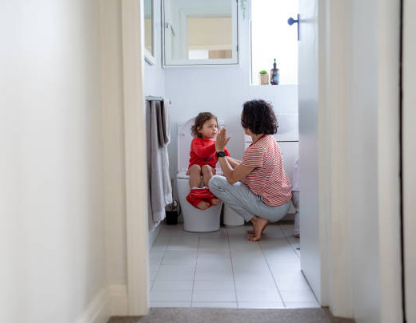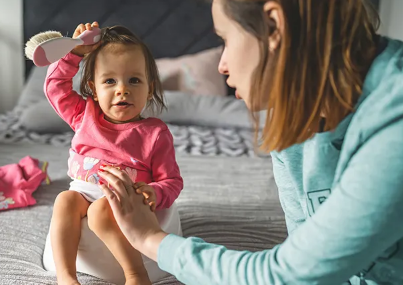You may have heard of various ways to train young children to use the toilet, and one of them is the three-day toilet training method. Although there is no foolproof potty training strategy for every child, you may think that this intensive bootcamp-style training method is right for you and your child. Read on to learn how to implement this method and gather general tips on potty training.
Choose a potty training method
Whether you choose to try a three-day potty training method or prefer a progressive technique, it’s helpful to understand that there is no evidence that one method is better than the other. However, it is best to start potty training for your child when they are mature and you are able to take a positive and consistent approach.

There’s also no need to use just one method. You can decide to combine different potty training methods to find what works for you and your child. Medical experts agree that children benefit greatly from a combination of verbal, physical, and social forms of training. These measures can include reading a book about potty training to your child, having them pick their own toilet chair, showing your child how to use the potty and wiping themselves down afterwards, and giving praise and hugs for well done work. Work with your child and their personality to develop the best combination of potty training methods for your family. You’ll get to know your child and their unique style better, and you’ll be happy to see them grow into an independent person.
6 tips to follow during potty training
Whether you’re just starting out in potty training or you’re already diving in, here are some potty training tips and tricks to keep in mind:
When you notice these signs, be prepared. If you find that your child needs to use the potty, quickly lead the way or grab the potty chair. Young children often don’t realize they need to go until the last minute.
Gently remind your child to use the potty. Often, when children are busy with an activity, they forget to go to the toilet or go to the toilet, which can lead to accidents. Consider reminding your child to use the potty every time you yourself need to go to the toilet. This can help your child reconfirm that everyone is using the toilet. As your child grows older and more independent, you may need to reduce reminders, as these can sometimes lead to resistance from your child.
Pay attention to your child’s daily Xi. Does your child need to use the potty immediately after waking up, after eating, or after getting in the car? Be mindful of your child’s needs and Xi and encourage them to stick to the potty during these times of the day.
Provide encouragement. Potty training requires mastering different techniques and steps, so be sure to be mindful of your child’s efforts along the way. For example, give them a high five when they tell you (without your prompting) that they need to go, and when they successfully use the potty themselves.
Stay calm in the event of an accident. In the early stages, you may need to help your child clean up and change clothes after an accident. But as long as they are able and gently encourage them to help clean up and change their own pants after an accident, this is not a form of punishment but a step towards greater independence.
Be patient and positive. Potty training takes time. It is possible to experience setbacks, such as regression in potty training, so stay positive and always look to the bright side: your child will eventually potty train!
Signs of readiness for potty training
Many parents think that their children should be potty trained when they reach a certain age, but this is not the case. Children are unique and they develop at different rates. One child may be ready to start potty training as early as 18 months of age, while the other child may not be ready until 3 months of age. Contrary to what you may have heard, not every preschooler is fully potty trained, and this is normal.
Don’t fall into the trap of comparing your child to other children, and don’t be ashamed that another parent didn’t train your child to use the potty sooner.
- If you’re wondering if it’s time to start the process, look for these signs of preparing for potty training in your child:
- They understand and use potty-related words such as pee and poop
- They associate the urge to go with the use of the potty
- They can stay dry for two hours or more
- They can follow the desired body movements: walk to the potty, take off their pants, sit on them, and then stand up and pull them up.

Three-day potty training method
If you decide to try a three-day potty training method, you may want to check if your child is there before you start
- Signs of readiness have been shown
- can control their bladder
- Know when it’s time to pee
- Possess the motor skills required for potty training, including undressing and dressing
- You can follow the instructions.
10 tips to follow during a three-day potty training session
Ready to try a three-day potty training method? Some parents prefer to schedule this on a long weekend so that there are fewer distractions or time commitments. No matter when you start, here are some tips and tricks on how to potty train in three days (or less):
- The day before the start, tell your child that from tomorrow they will be wearing older children’s underwear instead of diapers.
- Have the equipment you need: a potty chair to sit on the floor or, if you’re using a full-size toilet, a footstool to support your child, maybe a toilet mat, and a whole bunch of underwear.
- Show your child how to use the potty or toilet. A doll that will get itself wet helps demonstrate what to do.
- Encourage your child to drink plenty of fluids to help them Xi the urge to go.
- When your child feels the urge to go to the toilet, tell them to go to the potty, put down their pants, use the potty, wipe, stand up, pull up their pants, and wash their hands. Help them only when needed.
- Always check that your child’s pants are dry, especially on the first day.
- If there is an accident, don’t scold or punish your child, just admit it calmly and say “Oh, it looks like you had an accident”. Help your child clean up and gently remind them to tell you when they want to go.
- Go to the potty once more often and do frequent Xi exercises throughout the day to help reinforce positive results. These lessons can include using dolls to demonstrate proper toilet routines, showing your child the difference between wet and dry pants, and sitting on the potty.
- Praise your child when they are successfully using the potty. Consider putting stickers on potty training charts to show their progress.
- Eventually, by the second or third day, as your child gets better and better, Xi exercises and dryness checks can be reduced.
Some proponents of the three-day approach recommend the so-called “bare bottom” approach, which, as the name suggests, is just that. Not only do you not wear diapers, but you also give up your underwear and let your kids hang out around the house wearing only a long shirt or shirt and baggy pants (and if it’s warm enough, hang out in the backyard). Whether you buy lingerie or not, essentially you’ll be following the same strategy.
The Bottom Line
Whether you decide to try a three-day potty training method or a combination of methods for your child, be aware that potty training usually takes about six weeks, and it takes years for your child to fully potty train. The best course of action during this time is to potty train with an open mind and a flexible, positive attitude.
Potty training is not a fixed process, nor is it something that can be done overnight. Your child needs time to learn how Xi to use the potty successfully and eventually use the toilet, just as they will learn Xi any other new activity. Your child is growing on their own time, in their own way. Support their individuality and cheer for their progress!

